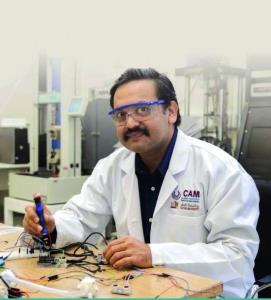(MENAFN- Gulf Times) Smart Nano Solutions research group at the Centre for Advanced Materials (CAM) at Qatar University (QU) has designed various sensors with great potential in different fields, such as food safety, environmental, and biomedical domains and many more.
Sensors are electronic devices composed of specialty electronics or materials for determining the presence of a particular entity or function. They operate in various manners, depending on their application and include electromagnetic fields, or optics, among others.
Led by Dr Kishor Kumar Sadasivuni, research assistant professor, the research group designed a non-invasive gas sensor using volatile organic compounds in human breath as an analyte to detect various metabolic diseases.
Gas sensors, capable of detecting and monitoring trace amounts of gas molecules or volatile organic compounds, are in great demand for numerous applications including diagnosing diseases through breath analysis. A smartphone-assisted unit consisting of a portable colorimetric device was used to detect relative red/green/blue values for practical and real-time application. The developed method could be used for rapid detection of ketones in patients with type 1 and 2 diabetes, or heart failure.
Most commercial food sensors in the market assess the food quality indirectly by monitoring environmental indicators such as temperature, humidity, and other changes. But CAM developed an inexpensive paper-based chemosensor to monitor the freshness of fish using trimethylamine as the sensing parameter.
This sensor will significantly impact situations like monitoring the freshness of fish and diagnosing trimethylaminuria where fast detection of trimethylamine exposure is required. The colour of the paper sensor changes differently in these paper sensor as the trimethylamine concentration increases, which helps to determine the immediate risk of trimethylamine in an environment.
In environmental monitoring, some of the designed sensors are used in advancing the capabilities of corrosion detection. One among them is based on the wireless, self-powered radio-frequency identification (RFID) as a corrosion detector and continuous remote sensing of these RFID sensors through a software-assisted corrosion monitoring system. These RFID tags can be embedded within the concrete structure and include metal bars itself as a part of a circuit for corrosion monitoring. The RFID sensors can be installed in different structures of the buildings and using the developed software, the real-time continuous corrosion mapping of the building can be done in a single slot.
A sensitive IoT-based colorimetric sensor prototype was also developed to detect formic acid, ethanol, and methanol in the atmosphere, which would have occurred because of CO2 conversion. Using the dyes as sensing elements, the sensor prototype showed unique RGB values upon exposure to test solutions and its concentration, based on the RGB values. The RGB data can be acquired using a mobile application.
Biomedical sensors are special electronic devices that can convert biomedical signals into easily measurable electric signals. Such biomedical sensors are also developed by the research group, which act as the key component in various medical diagnostic instruments and equipment like the tactile sensor that helps the surgeons to register the forces applied over the grasper of a surgical tooltip and can reduce the learning time for surgeons and help prevent injuries on the patient.
MENAFN22072023000067011011ID1106648675
Legal Disclaimer:
MENAFN provides the
information “as is” without warranty of any kind. We do not accept
any responsibility or liability for the accuracy, content, images,
videos, licenses, completeness, legality, or reliability of the information
contained in this article. If you have any complaints or copyright
issues related to this article, kindly contact the provider above.
























Comments
No comment